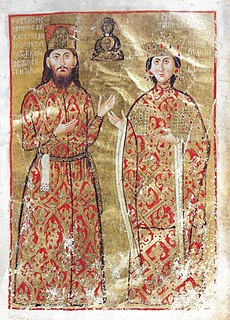John Kantakouzenos (Greek : Ἱωάννης Καντακουζηνός; ca. 1342 – after 1380) was a Byzantine prince.

Greek is an independent branch of the Indo-European family of languages, native to Greece, Cyprus and other parts of the Eastern Mediterranean and the Black Sea. It has the longest documented history of any living Indo-European language, spanning more than 3000 years of written records. Its writing system has been the Greek alphabet for the major part of its history; other systems, such as Linear B and the Cypriot syllabary, were used previously. The alphabet arose from the Phoenician script and was in turn the basis of the Latin, Cyrillic, Armenian, Coptic, Gothic, and many other writing systems.

The Byzantine Empire, also referred to as the Eastern Roman Empire or Byzantium, was the continuation of the Roman Empire in its eastern provinces during Late Antiquity and the Middle Ages, when its capital city was Constantinople. It survived the fragmentation and fall of the Western Roman Empire in the 5th century AD and continued to exist for an additional thousand years until it fell to the Ottoman Turks in 1453. During most of its existence, the empire was the most powerful economic, cultural, and military force in Europe. Both the terms "Byzantine Empire" and "Eastern Roman Empire" are historiographical terms created after the end of the realm; its citizens continued to refer to their empire simply as the Roman Empire, or Romania (Ῥωμανία), and to themselves as "Romans".
John is an obscure figure. Born ca. 1342, he was the eldest son of Matthew Kantakouzenos, co-emperor of the Byzantine Empire in 1353–1357, and Irene Palaiologina. On Matthew's abdication from the throne in December 1357, John V Palaiologos, now sole emperor, raised John to the supreme court rank of Despot. [1] [2]
Matthew Asen Kantakouzenos or Cantacuzenus was Byzantine Emperor from 1353 to 1357.
Irene Palaiologina, was the Empress consort of Matthew Kantakouzenos.

John V Palaiologos or Palaeologus was a Byzantine emperor, who succeeded his father in 1341 at the age of eight.
Little is known of John Kantakouzenos thereafter: in 1361 he went to the Morea, where he is again recorded ca. 1380 as the donor of an icon of the Theotokos, now in the church of San Samuele in Venice. [1] [2]

The Morea was the name of the Peloponnese peninsula in southern Greece during the Middle Ages and the early modern period. The name was used for the Byzantine province known as the Despotate of the Morea, by the Ottoman Empire for the Morea Eyalet, and by the Republic of Venice for the short-lived Kingdom of the Morea.

An icon is a religious work of art, most commonly a painting, in the cultures of the Eastern Orthodox Church, Oriental Orthodoxy, the Roman Catholic, and certain Eastern Catholic churches. The most common subjects include Christ, Mary, saints and angels. Although especially associated with "portrait" style images concentrating on one or two main figures, the term also covers most religious images in a variety of artistic media produced by Eastern Christianity, including narrative scenes. Icons can represent various scenes in the Bible.

Theotokos is a title of Mary, mother of Jesus, used especially in Eastern Christianity. The usual Latin translations, Dei Genetrix or Deipara, are "Mother of God" or "God-bearer".




